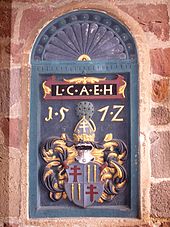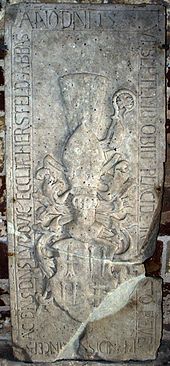Ludwig V (Hersfeld)


Ludwig V (born as Ludwig Landau around 1535/36 in Hünfeld ; died September 6, 1588 in Bad Hersfeld ) was abbot of the Imperial Abbey of Hersfeld from 1571 until his death .
Life
The exact date of birth of Ludwig Landau is not known. He was born around 1535 as the son of the wealthy Landau family in Hünfeld, which was then part of the Fulda Imperial Abbey . His mother Katharina Laun came from the neighboring Schlitz . According to his origins from the Fulda monastery , he was brought up Catholic. He received a higher education and finally decided to enter the clergy. Around 1560 he became a member of the monastery of the imperial abbey of Hersfeld, in whose area, unlike in the bishopric of Fulda, the Reformation had already made widespread use. There he apparently soon gained a high reputation and was elected coadjutor of Abbot Michael Landgraf . After he died on May 4, 1571, Ludwig Landau was elected abbot of the abbey at the age of about 35. His abbot's benediction took place in the same year, not as usual in the collegiate church, but in the Hersfeld town church, which was then used by both the Protestant town and the Catholic abbots . It was carried out by a vicar of the Bishop of Hildesheim .
The new abbot was mainly active in the cultural and architectural fields. He had Eichhof Palace , which Abbot Berthold II von Völkershausen built as a fortified castle for protection in his conflicts with the city of Hersfeld, converted into a summer palace in the Renaissance style. To decorate it, he commissioned a series of portraits of all of Hersfeld's abbots, of which only two have survived , including that of the founder of the monastery , Lullus . As a client, he also had the abbot's residence in the monastery district renewed and other buildings expanded and converted. His coat of arms reminds of this in various places, for example in Eichhof Castle and in the former chamber courtyard of the monastery on the market square. Partly from his own resources, partly from monastery funds, he also set up various scholarships , including attending the Fulda Jesuit College and the Hersfeld Monastery School, as well as charitable foundations. However, this also led to criticism that all funds from the abbey flowed to Fulda.
Abbot Ludwig V tried to secure the independence of the imperial abbey from the Hessian landgraves in the difficult tension of a Catholic monastery in an almost completely Protestant environment . The abbey had already recognized the landgrave as hereditary patron in 1432 and had to make further concessions to the landgraviate in the following period. Ludwig V was also forced to do so and left the city of Hersfeld to Landgrave Wilhelm IV as a fief. In 1572 he had to add Philipp Wilhelm von Cornberg , an illegitimate son of the Landgrave, to the monastery chapter , which only consisted of three people, and to transfer the still existing provost of the Cornberg Monastery as a benefice so that he could enjoy the income from this sinecure . When Philipp Wilhelm married in 1584 and left the chapter, the abbot had to hand over half of Cornberg belonging to the Hersfeld Abbey as a fiefdom under pressure from the Landgrave; he had already received the landgrave's half in 1580. Replacements for the monastery chapter were only possible with the consent of the evangelical landgrave. Nevertheless, Ludwig V tried to promote Catholicism, for example through the dedication of the scholarships he initiated. In 1577 he received from Emperor Rudolf II a confirmation of the earlier regalia of the abbey, in particular those that were established by Charlemagne , Otto I and Lothar III. had been granted.
From around 1580 Ludwig V was often ill. In February 1588, he and the Chapter confirmed the election of the dean Kraft Weiffenbach as his coadjutor, which, however, was no longer recognized by the Pope . Soon afterwards, Ludwig V died on September 6, 1588 at the age of 52. He was buried in the collegiate church. Kraft Weiffenbach became his successor. The gravestone of Ludwig V is the only one of a Hersfeld abbot to have survived and is located in the Bad Hersfeld monastery ruins on the southern inner wall of the vestibule.
literature
- Elisabeth Ziegler: With miter and crook - the abbots of the Reichskloster (the Reichsabtei) Hersfeld , in: Bad Hersfelder Jahresheft, Volume 16, Bad Hersfeld 1970, pp. 6–22
Web links
Individual evidence
- ↑ Abbot Ludwig, Dean Kraft Weiffenbach and Philipp Wilhelm ( JL Chr. Schmincke: History of the Cornberg Monastery according to documentary sources. In: Association for Hessian History and Regional Studies eV Kassel 1834 (ed.): Journal of the Association for Hessian History and Regional Studies , New Episode, first volume 1; Kassel, 1867, pp. 160-203 (178) ).
- ↑ Document 56 (773-1743) (old: MI Reichsabtei Hersfeld) 1782, Marburg, State Archives
| predecessor | Office | successor |
|---|---|---|
| Michael Landgrave |
Abbot of Hersfeld 1571 - 1588 |
Kraft Weiffenbach |
| personal data | |
|---|---|
| SURNAME | Ludwig V. |
| ALTERNATIVE NAMES | Landau, Ludwig |
| BRIEF DESCRIPTION | Abbot of Hersfeld |
| DATE OF BIRTH | 1535 or 1536 |
| PLACE OF BIRTH | Hünfeld |
| DATE OF DEATH | September 6, 1588 |
| Place of death | Bad Hersfeld |